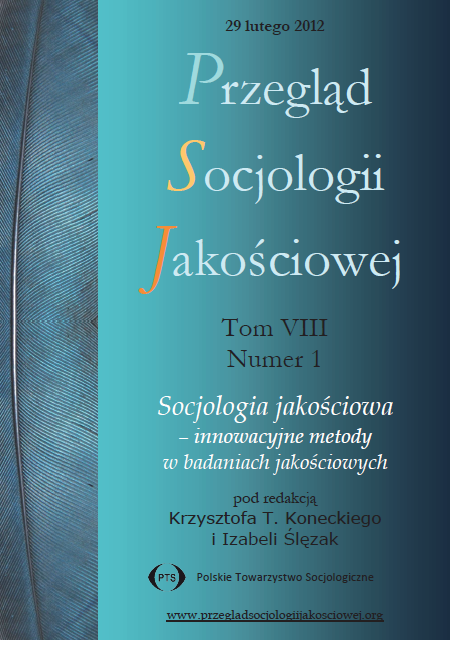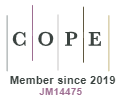Visual Grounded Theory. The Basic Rules and Procedures
DOI:
https://doi.org/10.18778/1733-8069.8.1.02Keywords:
grounded theory, visual grounded theory, visual studies, visual ethnography, visual data, qualitative research, qualitative data analysisAbstract
The article presents the basic concepts and methodological procedures of grounded theory methodology that uses visual data and is called visual grounded theory. It uses the visual data to construct categories, theoretical properties of categories for action and visual phenomena that manifest themselves as processes. Present article introduces, therefore, the rules and procedures for visual grounded theory based on both my own, and other authors research experience. In order to better illustrate the procedures in question, there are presented examples of these studies. The visual analysis is conducted at four levels: creating an image, its presentation, its content and structure and its reception. It is the basis for the concept of multislice imagining and visual grounded theory helps to reconstruct it..
Downloads
References
Banks Marcus (2007) Using Visual Qualitative Data. Los Aangeles, London, New Delhi, Singapore: Sage.
Google Scholar
Bryant Antony (2009) Grounded Theory and Pragmatism: The Curious Case of Anselm Strauss. „Forum Qualitative Sozialforschung / Forum: Qualitative Social Research”, vol. 10, no. 3, [dostęp 12 grudnia 2011]. Dostępny w Internecie http://nbn-resolving.de/urn:nbn:de:0114-fqs090325
Google Scholar
Bryant Anthony, Charmaz Kathy (2007) The Sage Handbook of Grounded Theory. Los Angeles, London, New Delhi, Singapore: Sage.
Google Scholar
DOI: https://doi.org/10.4135/9781848607941
Bryant Anthony, Charmaz Kathy (2007a) Grounded theory in historical perspective: An epistemological account [w:] Anthony Bryant, Kathy Charmaz, eds., The Sage Handbook of Grounded Theory. Los Angeles, London, New Delhi, Singapore: Sage, s. 31–57.
Google Scholar
DOI: https://doi.org/10.4135/9781848607941.n1
Byczkowska Dominika (2009) What do we study studying body? Researcher’s attempts to embodiment research. „Qualitative Sociology Review”, vol. 5, no. 3 [dostęp 30 lipca 2011]. Dostępny w Internecie http://www.qualitativesociologyreview.org/ENG/Volume14/QSR_5_3_Byczkowska.pdf
Google Scholar
DOI: https://doi.org/10.18778/1733-8077.5.3.07
Charmaz Kathy (2006) Constructing Grounded Theory. A Practical Guide Through Qualitative Analysis. London: Sage.
Google Scholar
Charmaz Kathy (2009) Teoria ugruntowana. Praktyczny przewodnik po analizie jakościowej. Przełożyła Barbara Komorowska. Warszawa: Wydawnictwo Naukowe PWN.
Google Scholar
Clarke Adele (2005) Situational Analysis: Grounded Theory after the Postmodern Turn. Thousand Oaks: Sage.
Google Scholar
Cohen Kris R. (2005) What Does the Photoblog Want? „Media, Culture and Society”, vol. 27, no. 6, s. 883–901.
Google Scholar
DOI: https://doi.org/10.1177/0163443705057675
Emmison Michael, Smith Philip (2000) Researching the Visual: images, objects, Contexts and interactions in social and cultural inquiry. London: Sage.
Google Scholar
Figueroa Silvana K. (2008) The Grounded Theory and the Analysis of Audio-Visual Texts. „International Journal of social research Methodology”, vol. 11, no. 3, s. 1–12.
Google Scholar
DOI: https://doi.org/10.1080/13645570701605897
Given John (2006) Narrating the Digital Turn: data deluge, technomethodology, and other likely tales. „Qualitative Sociology Review”, vol. 2, no. 1 [dostęp 12 grudnia 2009]. Dostępny w Internecie http://www.qualitativesociologyreview.org/ENG/Volume3/Article4.php
Google Scholar
DOI: https://doi.org/10.18778/1733-8077.2.1.05
Glaser Barney (1965) The Constant Comparative Method of Qualitative Analysis. „Social Problems”, vol. 12, no. 4, s. 436–445.
Google Scholar
DOI: https://doi.org/10.2307/798843
Glaser Barney (1978) Theoretical Sensitivity. San Francisco: The Sociology Press.
Google Scholar
Glaser Barney (1992) Basics of Grounded Theory Analysis. Mill Valley: The Sociology Press.
Google Scholar
Glaser Barney (1998) Doing Grounded Theory. Issues and Discussions. Mill Valley: The Sociology Press.
Google Scholar
Glaser Barney (2002) Constructivist Grounded Theory? „Forum Qualitative Sozialforschung / Forum: Qualitative Social Research”, vol. 3, no. 3 [dostęp 30 listopada 2007]. Dostępny w Internecie http://www.qualitative-research.net/fqs/fqs-eng.htm
Google Scholar
Glaser Barney, Strauss Anselm L. (1967) Discovery of Grounded Theory: Strategies for Qualitative Research. Chicago: Aldine.
Google Scholar
DOI: https://doi.org/10.1097/00006199-196807000-00014
Glaser Barney, Strauss Anselm L. (2009) Odkrywanie teorii ugruntowanej. Strategie badania jakościowego. Przełożył Marek Gorzko. Kraków: Nomos.
Google Scholar
Goode David (2007) Playing With My Dog Katie. An Ethnomethodological Study of Canine – Human Interaction. West Lafayette: Purdue University Press.
Google Scholar
Heath Christian, Luff Paul (2007) Ordering competition: the interactional accomplishment of the sale of fine art and antiques at auction. „British Journal of Sociology”, vol. 58, no.1, s. 63–85.
Google Scholar
DOI: https://doi.org/10.1111/j.1468-4446.2007.00139.x
Heath Christian, Luff Paul (2007a) Gesture and institutional interaction: figuring bids in auctions of fine art and antiques. „Gesture”, vol. 7, no. 2, s. 215–241.
Google Scholar
DOI: https://doi.org/10.1075/gest.7.2.05hea
Kelle Udo (2005) “Emergence” vs. “Forcing” of Empirical Data? A Crucial Problem of “Grounded Theory” Reconsidered. „Forum Qualitative Sozialforschung / Forum: Qualitative Social Research”, vol. 6, no. 2 [dostęp 26 stycznia 2008]. Dostępny w Internecie http://www.qualitative-research.net/fqs-texte/2-05/05-2-27-e.htm
Google Scholar
Knoblauch Hubert (2005) Focused Ethnography. „Forum Qualitative Sozialforschung / Forum: Qualitative Social Research”, vol. 6, no. 3 [dostęp 4 kwietnia 2007]. Dostępny w Internecie http://www.qualitative-research.net/fqs-texte/3-05/05-3-44-e.htm
Google Scholar
Knoblauch Hubert (2008) The Performance of Knowledge: Pointing and Knowledge in Powerpoint Presentations. „Cultural Sociology”, vol. 2, no. 1, s. 75–97.
Google Scholar
DOI: https://doi.org/10.1177/1749975507086275
Konecki Krzysztof Tomasz (2008) Touching and Gesture Exchange as an Element of Emotional Bond Construction. Application of Visual Sociology in the Research on Interaction between Humans and Animals. „Forum Qualitative Sozialforschung” / „Forum: Qualitative Social Research”, vol. 9, no. 3 [dostęp 15 października 2011]. Dostępny w Internecie http://nbn-resolving.de/urn:nbn:de:0114-fqs0803337
Google Scholar
Konecki Krzysztof Tomasz (2008a) Grounded Theory and Serendipity. Natural History of a Research. „Qualitative Sociology Review”, vol. 4, no. 1 [dostęp 15 grudnia 2009]. Dostepny w Internecie http://www.qualitativesociologyreview.org/ENG/Volume9/QSR_4_1_Konecki.pdf
Google Scholar
DOI: https://doi.org/10.18778/1733-8077.4.1.09
Konecki Krzysztof Tomasz (2009) Teaching Visual Grounded Theory. „Qualitative Sociology Review”, vol. 5, no. 3 [dostęp 28 stycznia 2009]. Dostępny w Internecie http://www.qualitativesociologyreview.org/ENG/Volume14/QSR_5_3_Konecki.pdf
Google Scholar
DOI: https://doi.org/10.18778/1733-8077.5.3.05
Olechnicki Krzysztof (2009) Fotoblogi, pamiętniki z opcją przekazu. Fotografia i fotoblogerzy w kulturze konsumpcyjnej. Warszawa: Wydawnictwo Akademickie i Profesjonalne.
Google Scholar
Pauwels Luc (2011) Zwrot wizualny w badaniach i komunikacji wiedzy. Kluczowe problemy rozwijania kompetencji wizualnej w naukach społecznych [w:] Maciej Frąckowiak, Krzysztof Olechnicki, red., Badania wizualne w działaniu. Antologia tekstów. Warszawa: Fundacja Nowej Kultury Bęc Zmiana, s. 21–36.
Google Scholar
Pink Sarah (2007) Doing Visual Ethnography. London, Thousand Oaks, New Delhi: Sage.
Google Scholar
DOI: https://doi.org/10.4135/9780857025029
Puddephatt Antony J. (2006) An Interview with Kathy Charmaz: On Constructing Grounded Theory. „Qualitative Sociology Review”, vol. 2, no. 3 [dostęp 12 grudnia 2009]. Dostępny w Internecie http://www.qualitativesociologyreview.org/ENG/archive_eng.php
Google Scholar
DOI: https://doi.org/10.18778/1733-8077.2.3.02
Schubert Cornelius (2006) Video Analysis of Practice and Practice of Video Analysis. Selecting field and focus in videography [w:] Hubert Knoblauch i in., eds., Video Analysis: Methodology and Methods. Qualitative Audiovisual Data Analysis in Sociology. Frankfurt am Main: Peter Lang, s. 115–126.
Google Scholar
Silverman David (2007) A Very Short, Fairly Interesting And Reasonably Cheap Book About Qualitative Research. Los Angeles, London, New Delhi, Singapore: Sage.
Google Scholar
Singleton Marc (2010) Yoga Body. The origins of Modern Posture Practice. Oxford: Oxford University Press.
Google Scholar
Strauss Anselm (1976) Images of the American City. New Brunswick, New Jersey: Transaction Books.
Google Scholar
Strauss Anselm (1978) A social world perspective [w:] Norman Denzin, ed., Studies in Symbolic Interaction. Volume 1. Greenwich: JAI Press, s. 119–128.
Google Scholar
Strauss Anselm (1987) Qualitative Analysis for Social Scientists. Cambridge: Cambridge University Press.
Google Scholar
DOI: https://doi.org/10.1017/CBO9780511557842
Strauss Anselm, Corbin Juliet (1990) Basics of Qualitative Research. London: Sage.
Google Scholar
Strübing Jörg (2004) Grounded Theory. Zur sozialtheoretischen und epistemologischen Fundierung des Verfahrens der empirisch begründeten Theoriebildung (Reihe: Qualitative Sozialforschung Bd. 15). Wiesbaden: VS Verlag für Sozialwissenschaften.
Google Scholar
Suchar Charles (1997) Grounding visual research in shooting scripts. „Qualitative Sociology”, vol. 20, no. 1, s. 33–55.
Google Scholar
DOI: https://doi.org/10.1023/A:1024712230783
Sztompka Piotr (2005) Socjologia wizualna: fotografia jako metoda badawcza. Warszawa: Wydawnictwo Naukowe PWN.
Google Scholar
Walker Andrew L., Moulton Kimball Rosalind (1989) Photo Albums: Images of Time and Reflections of Self. „Qualitative Sociology”, vol. 12, no. 2, s. 155–182.
Google Scholar
DOI: https://doi.org/10.1007/BF00988996
Downloads
Published
How to Cite
Issue
Section
License

This work is licensed under a Creative Commons Attribution-NonCommercial-NoDerivatives 4.0 International License.














